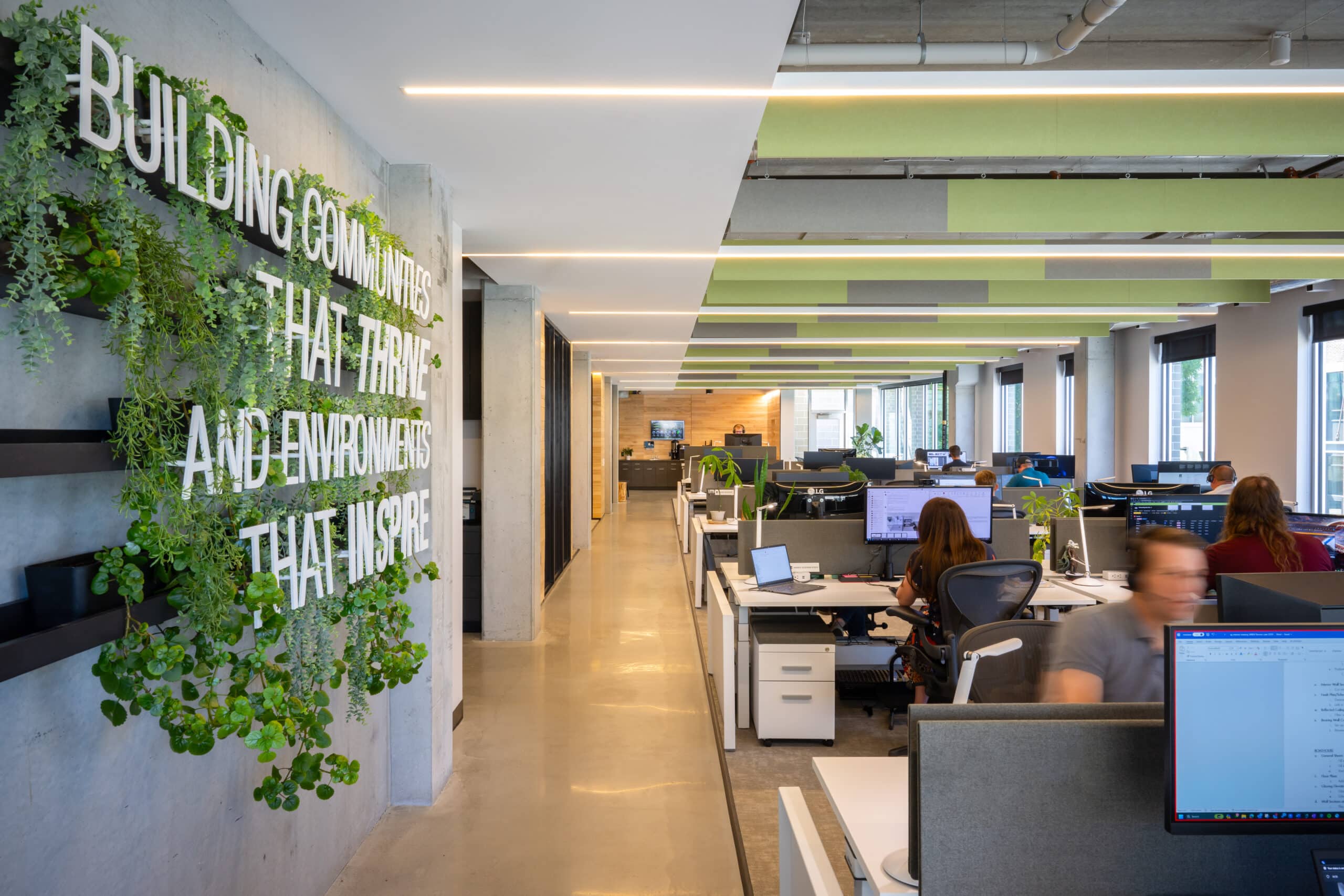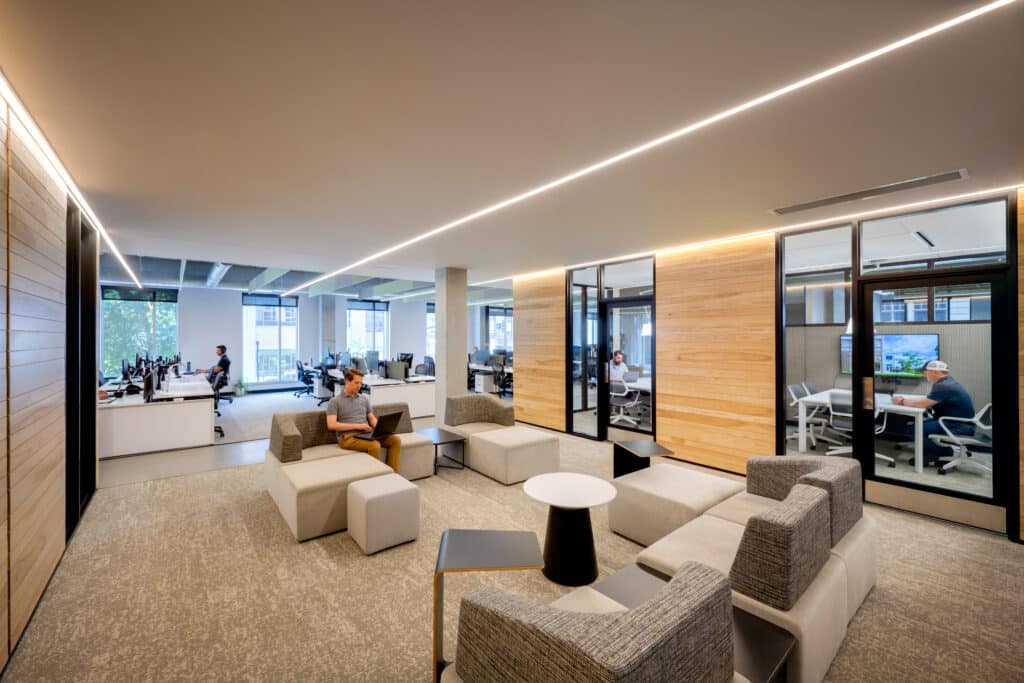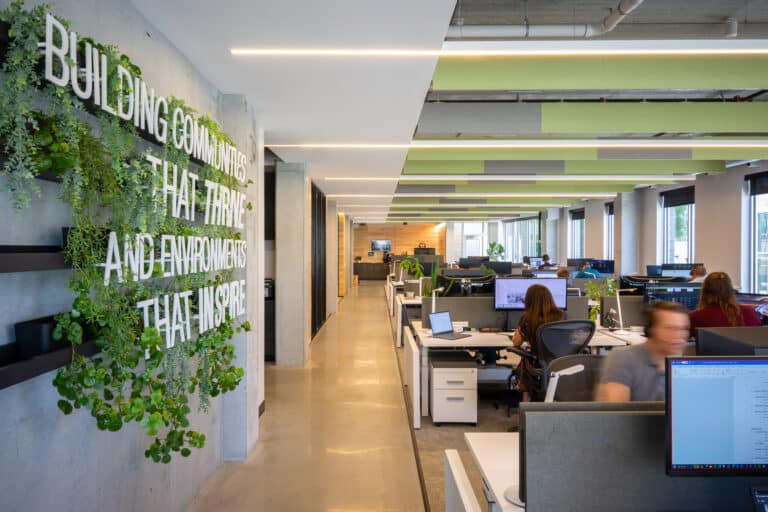GRAND FORKS, N.D. – July 25, 2024 – In Downtown Grand Forks, ND, JLG Architects’ new office in The Argyle has been awarded LEED® 4.1 Platinum certification by the U.S. Green Building Council®. This office is the second commercial Platinum building in North Dakota – the first is the University of North Dakota Gorecki Alumni Center, also designed by JLG. The firm’s Grand Forks workspace is the first in the state to follow the LEED 4.1 Commercial Interiors Platinum guidelines.
To achieve LEED® certification within The Argyle’s new construction and JLG’s second-floor office fit-up, the firm underwent a rigorous review process conducted by the U.S. Green Building Council®. The LEED® rating system is based on a point system for meeting specific building criteria in categories such as energy efficiency, water conservation, and indoor environmental quality. The more points a building earns, the higher its LEED rating. JLG navigated all four levels of LEED certification: Certified (40-49 points), Silver (50-59 points), and Gold (60-79 points), before earning the highest certification of Platinum (80+ points).
Prior to LEED® certification, the firm’s Grand Forks office earned two additional firsts in the state with a Fitwell-certified site and the JLG Design Excellence Guide (DEG) FDE Score of four out of four. JLG is also vying for Living Building Challenge certification pending completion of the performance measurement period, which is underway now and trending positive for net zero energy performance. When completed, the firm will earn another milestone with the state’s first full Living Building Challenge-certified commercial project.
“JLG is employee-owned, with nine offices across the Midwest. When we design our workplaces, we view each space as a “Living Lab of Learning,” where we can leverage sustainability in action – demonstrating design exploration, education, and best practices for our clients,” said JLG’s Principal Sustainability Officer, Patrick Thibaudeau. “Sustainable building practices are here to stay, and the best thing we can do is educate clients on the benefits of early integration, at the start of every new project. The work we’re doing is changing business as usual, proving return on investment, and propelling JLG into a national leadership position, with rigorous certifications that hold our team and partners accountable. Today, the cost difference is minimal, and the long-term savings are often substantial.”

JLG completed the firm’s second-floor office fit-up, along with The Argyle’s development and design in 2022 with Community Contractors. The building is named for the Argyle Block, which occupied the area from 1914 to 1997, after which it was demolished due to extensive flood damage. New construction on the once vacant lot and prominent downtown corner of Fourth Street and DeMers Avenue enabled the team to capture natural light and skyline views overlooking the nearby park and Red River. The building and fit-up, with solar arrays on the roof, provide substantial operational savings through efficiencies and reduction in heating, cooling, and water use. The five-story development is comprised of 23 market-rate apartments on the top three floors, JLG’s office space, and street-level retail.
About LEED® Certification
According to the U.S. Green Building Council®, LEED® (Leadership in Energy and Environmental Design) is the world’s most widely used green building rating system; a globally recognized symbol of sustainability achievement and a critical step in addressing climate change, enhancing resilience, and supporting more equitable communities. LEED® certification provides a framework for healthy, highly efficient, and cost-saving green buildings, which offer environmental, social, and governance benefits.
LEED® buildings use less energy and water, utilize renewable energy and fewer resources, create less waste, and preserve land and habitat. Through sustainable design, construction and operations, LEED® helps new and existing buildings reduce carbon emissions, energy and waste, conserve water, prioritize safer materials, and lower exposure to toxins.
To achieve LEED® certification, projects earn points by adhering to prerequisites and credits that address carbon, energy, water, waste, transportation, materials, health, and indoor environmental quality. Projects then go through a verification and review process by Green Business Certification Inc. and are awarded points that correspond to a level of certification: Certified (40-49 points), Silver (50-59 points), Gold (60-79 points) and Platinum (80+ points).
Of all LEED® credits, 35% typically relate to climate change, 20% directly impact human health, 15% impact water resources, 10% affect biodiversity, 10% relate to the green economy, and 5% impact community and natural resources. In LEED v4.1, most LEED credits are related to operational and embodied carbon.
Learn more at: LEED rating system | U.S. Green Building Council (usgbc.org)


